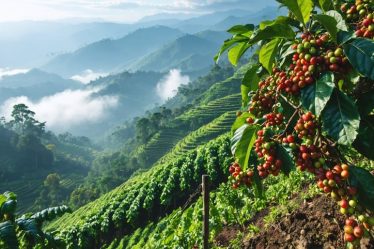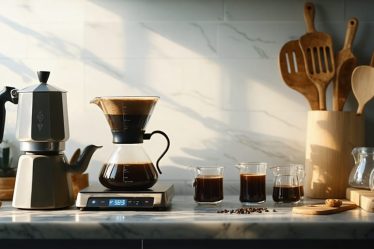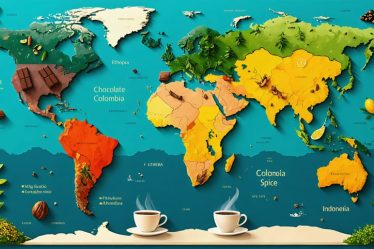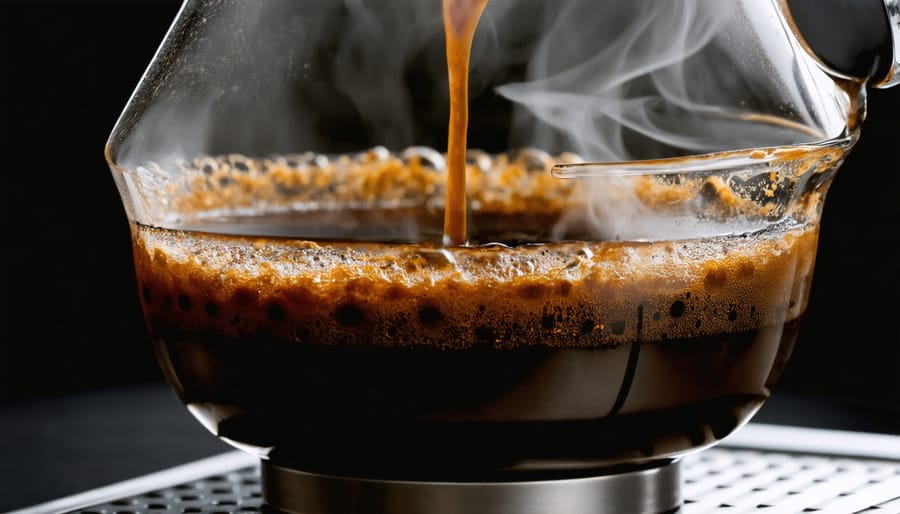
Every morning, as you stand before your coffee maker watching that aromatic brown liquid drip into your carafe, you’re actually witnessing an intricate dance of chemistry in action. The transformation of coffee beans and water into your beloved morning brew isn’t just a simple mixing process – it’s a fascinating example of chemical change that happens right in your kitchen. As hot water flows through your ground coffee beans, it triggers a complex series of reactions, extracting over 1,000 different chemical compounds that create that distinctive coffee flavor and aroma you crave. Whether you’re a chemistry enthusiast or simply curious about the science behind your daily ritual, understanding the chemical magic of coffee brewing can help you craft the perfect cup while appreciating the sophisticated process taking place in your humble coffee maker. Let’s explore what makes this everyday transformation a true chemical reaction and how you can use this knowledge to elevate your coffee game.
The Magic Behind Your Morning Brew
When Water Meets Coffee: The First Reaction
Picture this: you’re about to create your morning coffee, armed with fresh grounds and hot water. What happens next is nothing short of magical chemistry! When hot water first meets your coffee grounds, an exciting process called “blooming” begins. During these initial moments, the coffee grounds release trapped CO2 gases, creating tiny bubbles that you might notice rising to the surface.
This first contact is crucial for extracting those delightful flavors we all love. The hot water causes the coffee grounds to expand and open up, similar to how a flower blooms – hence the term “blooming.” As part of our pro brewing secrets, letting your coffee bloom for about 30 seconds allows for better extraction later.
During this initial reaction, the water begins dissolving water-soluble compounds within the coffee grounds. These include caffeine, acids, and various flavor compounds that give your coffee its distinct taste and aroma. The temperature of your water plays a vital role here – too hot, and you might over-extract bitter compounds; too cool, and you’ll miss out on essential flavors.
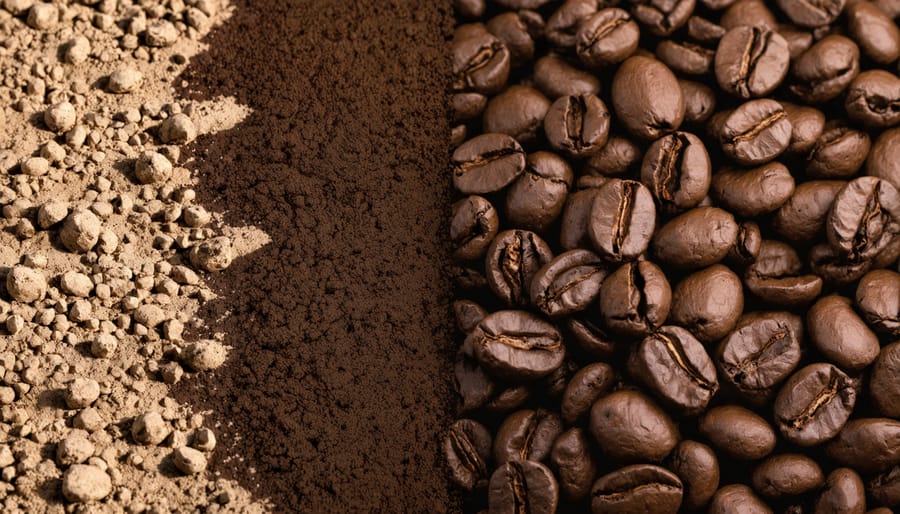
Signs of Chemical Change in Your Cup
Ever wondered how you can tell that magical transformation is happening in your morning brew? As a fellow coffee enthusiast, I love observing the telltale signs that show my coffee is undergoing a chemical change right before my eyes.
When hot water meets your coffee grounds, several fascinating changes occur. First, you’ll notice the enchanting aroma that fills your kitchen – this isn’t just a pleasant wake-up call, it’s actually aromatic compounds being released through a process called extraction. Watch as your coffee grounds begin to bloom and bubble when they first meet hot water – that’s carbon dioxide being released, creating those tiny bubbles you see.
The color change is perhaps the most obvious sign – clear water transforms into that rich, dark brown liquid we all love. This happens because water-soluble compounds are being extracted from the coffee beans. You might also notice how the texture of your coffee changes, becoming more viscous than plain water, thanks to the oils and dissolved solids now suspended in your cup.
These visible changes aren’t just beautiful to watch – they’re your guarantee that you’re getting all those wonderful coffee compounds that make your morning brew so special.
Your Water Quality Makes All the Difference
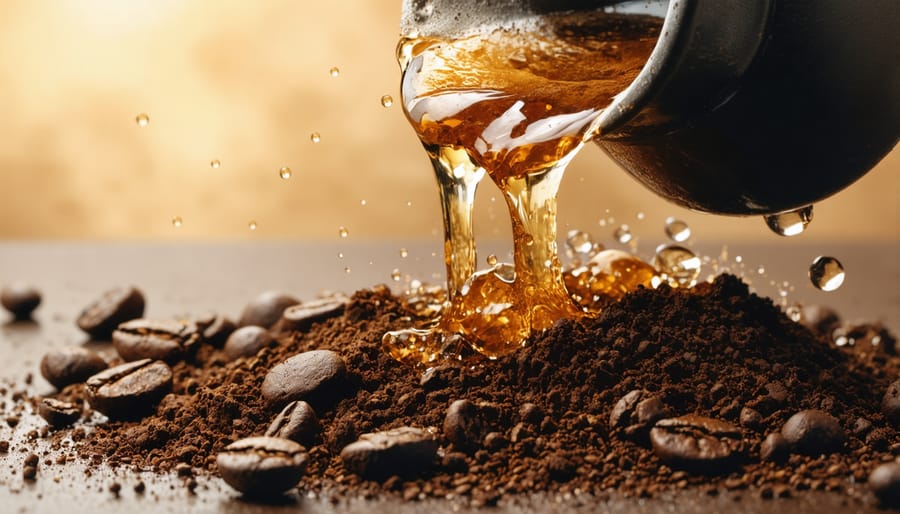
Hard vs. Soft Water: Which Makes Better Coffee?
Did you know that your morning coffee’s taste might depend on something as simple as your tap water? It’s fascinating how water quality affects coffee taste in ways we might not expect.
Let me share a little coffee revelation I had when I moved across town. My usual coffee beans suddenly tasted different, and it wasn’t until I chatted with my local barista that I discovered why: hard water versus soft water makes a huge difference!
Hard water, which contains more minerals like calcium and magnesium, typically creates a fuller-bodied, more complex cup of coffee. These minerals help extract more flavor compounds from your grounds. Think of it as having tiny flavor helpers that pull out all those delicious notes from your beans.
Soft water, on the other hand, has fewer minerals and tends to produce a lighter, sometimes brighter cup. While this might sound less appealing, it can actually be perfect for bringing out the subtle fruity or floral notes in lighter roasts.
Here’s a quick tip from my own kitchen experiments: if you’re using hard water, you might want to clean your coffee maker more frequently to prevent mineral buildup. And if you’re dealing with soft water, consider adjusting your grind size slightly finer to help with extraction.
Perfect Water Temperature for Chemical Reactions
Ever noticed how your coffee tastes different when you use water that’s too hot or too cold? I learned this the hard way after countless mornings of bitter brews! The perfect water temperature for brewing coffee typically falls between 195°F and 205°F (90-96°C). This sweet spot isn’t just about taste – it’s actually crucial for the chemical reactions that transform those humble coffee grounds into your morning masterpiece.
Think of it like a delicate dance: too hot, and you’ll over-extract the beans, releasing bitter compounds that can make your coffee taste harsh. Too cold, and you’ll under-extract, missing out on those complex flavors we all love. When the water hits that perfect temperature, it efficiently dissolves the soluble compounds in your coffee grounds, releasing just the right balance of acids, oils, and aromatics.
I remember one coffee shop owner telling me that water temperature is like the conductor of an orchestra – it determines how each element performs in the final composition. The heat energy from the water helps break down the coffee’s cellular structure, allowing those wonderful flavors and aromas to be released through a process called extraction.
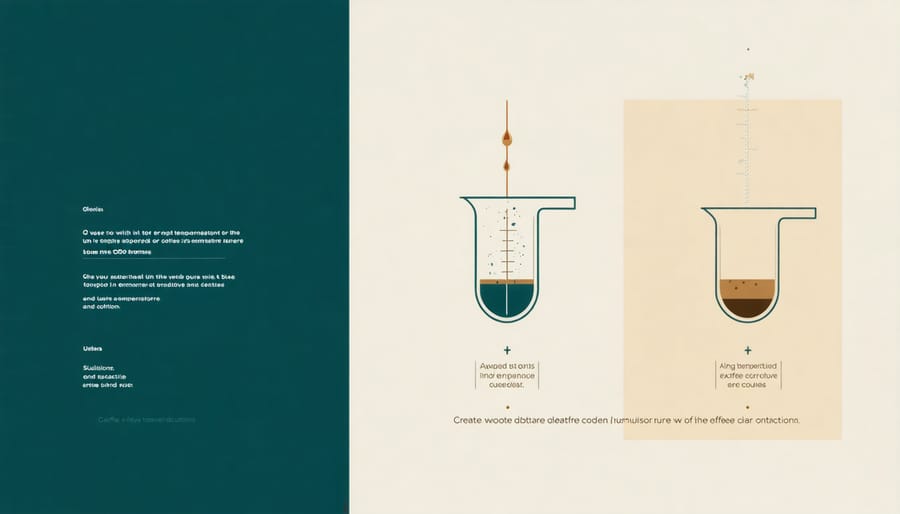
Making Better Coffee Through Chemistry
Now that we understand the chemistry behind brewing coffee, let’s put that knowledge to work in your kitchen! The key to a perfect cup starts with keeping coffee fresh and using the right water temperature. Aim for water between 195-205°F (91-96°C) – this sweet spot allows for optimal extraction of those wonderful flavor compounds we talked about earlier.
Here’s a game-changer I discovered: filtered water makes a huge difference! Those minerals in your tap water can affect how the chemical reactions occur during brewing. If your water is too hard or soft, it might not extract the coffee compounds properly.
Pay attention to your grind size too. Finer grounds increase the surface area for chemical reactions, leading to stronger extraction. For pour-over methods, medium-fine works best, while espresso needs a fine grind.
Timing matters as well! The longer hot water contacts your grounds, the more compounds are extracted. But be careful – over-extraction can release those bitter compounds we’d rather avoid. For most brewing methods, aim for 3-4 minutes of contact time.
Now that you understand the fascinating chemical transformation happening in your daily brew, why not experiment with your coffee-making process? Try adjusting water temperatures, grind sizes, or brewing times to discover your perfect cup. Remember, each adjustment influences the chemical reactions, ultimately affecting your coffee’s taste and aroma. Whether you’re a chemistry enthusiast or simply a coffee lover, brewing the perfect cup is both a science and an art worth mastering.

